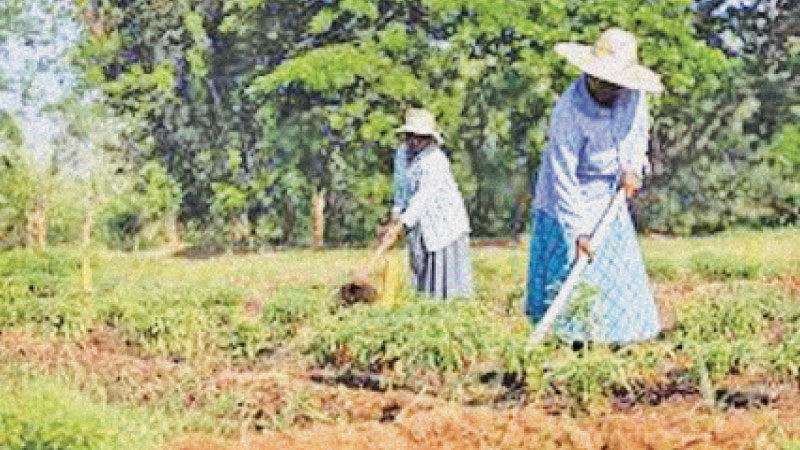Sri Lanka is facing an escalating food security crisis driven by climate change, which manifests in unpredictable weather patterns, declining agricultural productivity, and increased risk of droughts and floods.
Addressing these challenges needs innovative, human-centered solutions based on design thinking principles.
This article presents a 25-point action plan integrating agricultural adaptation, technological innovation, policy reform, environmental protection, and community engagement, benchmarked against successful global models. By employing a design thinking model, this action plan offers a pathway for Sri Lanka to enhance food security, improve resilience, and transform its agricultural landscape in the face of climate change.
Introduction: A Design Thinking approach to agricultural challenges
Sri Lanka’s agricultural sector is heavily impacted by climate change, with farmers struggling to maintain productivity amidst erratic weather patterns, reduced access to water, and deteriorating soil health. The design thinking model emphasises empathy, ideation, and prototyping solutions that address complex problems from a holistic perspective.
This approach enables agricultural stakeholders to co-create solutions with farmers, policymakers, and environmental scientists, ensuring that interventions are practical and sustainable. By benchmarking successful projects from around the world, this article offers a blueprint for revitalising Sri Lankan agriculture.
The 25-point action plan
1. Agricultural adaptation and resilience
Promote Climate-Resilient Crops: Emphasise research and cultivation of drought-resistant and heat-tolerant crop varieties, as successfully implemented in India and Ethiopia.
Expand Agroforestry: Integrate trees and crops to improve biodiversity, reduce soil erosion, and enhance water retention. Kenya’s Green Belt Movement serves as a model for this approach. Enhance Soil Management: Adopt practices like crop rotation and organic fertiliser to maintain soil health. Australia’s National Soil Strategy offers an example of sustainable soil management. Boost water efficiency: Encourage the use of water-efficient technologies, such as Israel’s drip irrigation systems, to minimise water waste and maximise crop yields.
Diversify agriculture: Reduce reliance on monocultures by promoting a diverse array of crops, building resilience to extreme weather.
2. Technological integration
Precision agriculture: Leverage satellite imagery, drones, and AI to optimise water and fertiliser use, a method successfully employed in the Netherlands.
Early warning systems: Develop climate prediction tools to provide farmers with advanced warnings of extreme weather events, as seen in Ethiopia’s LEAP Early Warning System.
Urban farming: Promote rooftop and vertical farming, which can increase food production in urban areas. Singapore’s rooftop farming initiative demonstrates the potential of this strategy. Genetic engineering: Support the safe use of genetically modified crops to improve yields and resistance to climate stressors. Kenya’s GM drought-resistant maize offers a blueprint.
3. Policy and infrastructure
Strengthen food security policies: Create comprehensive food security frameworks, drawing inspiration from Brazil’s Zero Hunger program.
Subsidies for sustainable farming: Introduce financial incentives for farmers who adopt eco-friendly practices, similar to the European Union’s Common Agricultural Policy.
Support smallholder farmers: Provide technical assistance and financial literacy programs for smallholders, ensuring equitable access to resources. Modernise food storage: Build climate-resilient storage facilities to reduce post-harvest losses, following Rwanda’s successful post-harvest handling programs.
Strengthen supply chains: Diversify and stabilise agricultural supply chains, mitigating disruptions due to climate events. Japan’s approach to diversifying supply chains serves as a useful model.
4. Environmental protection
Reforest degraded lands: Initiate reforestation projects that restore ecosystems and enhance water retention, following China’s Green Great Wall.
Wetland conservation: Protect wetlands, which act as natural buffers against flooding and drought, as seen in Bangladesh’s wetland management programs.
Enhance coastal protection: Support mangrove restoration and coral reef protection, using Indonesia’s Mangrove Rehabilitation Projects as a guide. Developed by Lalin De Silva.
5. Community and social engagement
Promote local food systems: Encourage community-supported agriculture (CSA) and farmers’ markets to improve local food resilience. Support farmer cooperatives: Establish cooperatives that allow farmers to pool resources and improve market access, based on India’s successful smallholder farmer cooperatives.
Climate education: Launch nationwide educational campaigns to raise awareness of sustainable farming practices and climate impacts.
Expand social safety nets: Strengthen food aid programs to protect vulnerable populations, learning from Brazil’s Bolsa Familia program.
6. Financial and market support
Agricultural insurance: Provide farmers with crop insurance to protect against climate-related risks, following India’s Fasal Bima Yojana initiative.
Research and development: Invest in R&D to develop climate-resilient crops and sustainable farming practices, emulating the leadership of Wageningen University in the Netherlands. Climate-resilient infrastructure: Develop resilient transport and distribution systems, especially for food storage, drawing from Bangladesh’s flood-resilient infrastructure.
International cooperation: Collaborate with global organisations such as FAO and WFP to share knowledge and secure funding for climate-resilient agriculture. The way forward: implementing the design thinking model
Addressing Sri Lanka’s food shortages requires a fundamental shift in the way agricultural problems are approached. Using the design thinking model, stakeholders can engage directly with farmers, testing new technologies, and policies in a co-creative, iterative process. The focus should be on: Empathy: Understand the needs of farmers and communities affected by climate change. Define: Clearly identify the key challenges facing agriculture, such as water scarcity, soil degradation, and market access. Ideation: Generate creative solutions by learning from successful models in other countries.
Prototyping and Testing: Pilot new technologies, crop varieties, and policy initiatives in small regions before scaling up. Implementation: Roll out the action plan nationwide, ensuring policies are adaptable to local contexts and feedback is continuously integrated.
Sri Lanka is at a critical juncture in its fight against climate-driven food shortages. By adopting a design thinking approach and learning from successful international models, the country can build a resilient agricultural sector that not only ensures food security but also contributes to long-term economic and environmental sustainability. This 25-point action plan offers a comprehensive pathway to achieving this goal, turning challenges into opportunities for a more secure and prosperous future. Also promote locally adapted drought-resistant edible plant varieties that can withstand extreme conditions such as prolonged drought, heavy rainfall, and pest and disease challenges commonly faced in Sri Lanka.
The writer is a Senior Lecturer at the Department of Crop Science, University of Ruhuna.









